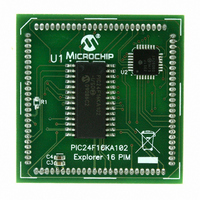MA240017 Microchip Technology, MA240017 Datasheet - Page 99

MA240017
Manufacturer Part Number
MA240017
Description
MODULE PLUG-IN PIC24F16KA102 PIM
Manufacturer
Microchip Technology
Series
PIC®r
Specifications of MA240017
Accessory Type
Plug-In Module (PIM) - PIC24F16KA102
Product
Microcontroller Modules
Data Bus Width
16 bit
Core Processor
PIC24F16KA102
Operating Supply Voltage
3 V to 3.6 V
Development Tools By Supplier
Integrated Development Environment, Assembler, ANSI C Compiler
Processor Series
PIC24F
Silicon Manufacturer
Microchip
Core Architecture
PIC
Core Sub-architecture
PIC24
Silicon Core Number
PIC24F
Silicon Family Name
PIC24FxxKAxx
Lead Free Status / RoHS Status
Lead free / RoHS Compliant
For Use With/related Products
Explorer 16 (DM240001 or DM240002)
For Use With
DM240001 - BOARD DEMO PIC24/DSPIC33/PIC32
Lead Free Status / Rohs Status
Lead free / RoHS Compliant
Available stocks
Company
Part Number
Manufacturer
Quantity
Price
Company:
Part Number:
MA240017
Manufacturer:
MICROCHIP
Quantity:
12 000
- Current page: 99 of 254
- Download datasheet (4Mb)
9.4
With few limitations, applications are free to switch
between any of the four clock sources (POSC, SOSC,
FRC and LPRC) under software control and at any
time. To limit the possible side effects that could result
from this flexibility, PIC24F devices have a safeguard
lock built into the switching process.
9.4.1
To enable clock switching, the FCKSM1 Configuration bit
in the FOSC Configuration register must be programmed
to ‘0’. (Refer to Section 26.1 “Configuration Bits” for
further details.) If the FCKSM1 Configuration bit is unpro-
grammed (‘1’), the clock switching function and FSCM
function are disabled. This is the default setting.
The NOSCx control bits (OSCCON<10:8>) do not
control the clock selection when clock switching is
disabled. However, the COSCx bits (OSCCON<14:12>)
will reflect the clock source selected by the FNOSCx
Configuration bits.
The OSWEN control bit (OSCCON<0>) has no effect
when clock switching is disabled; it is held at ‘0’ at all
times.
9.4.2
At a minimum, performing a clock switch requires this
basic sequence:
1.
2.
3.
4.
5.
© 2009 Microchip Technology Inc.
Note:
If desired, read the COSCx bits (OSCCON<14:12>),
to determine the current oscillator source.
Perform the unlock sequence to allow a write to
the OSCCON register high byte.
Write the appropriate value to the NOSCx bits
(OSCCON<10:8>) for the new oscillator source.
Perform the unlock sequence to allow a write to
the OSCCON register low byte.
Set the OSWEN bit to initiate the oscillator
switch.
Clock Switching Operation
The primary oscillator mode has three
different submodes (XT, HS and EC),
which are determined by the POSCMDx
Configuration bits. While an application
can switch to and from primary oscillator
mode in software, it cannot switch
between the different primary submodes
without reprogramming the device.
ENABLING CLOCK SWITCHING
OSCILLATOR SWITCHING
SEQUENCE
Preliminary
PIC24F16KA102 FAMILY
Once the basic sequence is completed, the system
clock hardware responds automatically as follows:
1.
2.
3.
4.
5.
6.
Note 1: The processor will continue to execute
The clock switching hardware compares the
COSCx bits with the new value of the NOSCx
bits. If they are the same, then the clock switch
is a redundant operation. In this case, the
OSWEN bit is cleared automatically and the
clock switch is aborted.
If a valid clock switch has been initiated, the
LOCK (OSCCON<5>) and CF (OSCCON<3>)
bits are cleared.
The new oscillator is turned on by the hardware
if it is not currently running. If a crystal oscillator
must be turned on, the hardware will wait until
the OST expires. If the new source is using the
PLL, then the hardware waits until a PLL lock is
detected (LOCK = 1).
The hardware waits for 10 clock cycles from the
new clock source and then performs the clock
switch.
The hardware clears the OSWEN bit to indicate a
successful clock transition. In addition, the
NOSCx bits value is transferred to the COSCx
bits.
The old clock source is turned off at this time,
with the exception of LPRC (if WDT, FSCM or
RTCC with LPRC as clock source are enabled)
or SOSC (if SOSCEN remains enabled).
2: Direct clock switches between any
code throughout the clock switching
sequence. Timing-sensitive code should
not be executed during this time.
primary oscillator mode with PLL and
FRCPLL mode are not permitted. This
applies to clock switches in either
direction.
application must switch to FRC mode as
a transition clock source between the two
PLL modes.
In
these
DS39927B-page 97
instances,
the
Related parts for MA240017
Image
Part Number
Description
Manufacturer
Datasheet
Request
R

Part Number:
Description:
Manufacturer:
Microchip Technology Inc.
Datasheet:

Part Number:
Description:
Manufacturer:
Microchip Technology Inc.
Datasheet:

Part Number:
Description:
Manufacturer:
Microchip Technology Inc.
Datasheet:

Part Number:
Description:
Manufacturer:
Microchip Technology Inc.
Datasheet:

Part Number:
Description:
Manufacturer:
Microchip Technology Inc.
Datasheet:

Part Number:
Description:
Manufacturer:
Microchip Technology Inc.
Datasheet:

Part Number:
Description:
Manufacturer:
Microchip Technology Inc.
Datasheet:

Part Number:
Description:
Manufacturer:
Microchip Technology Inc.
Datasheet:











